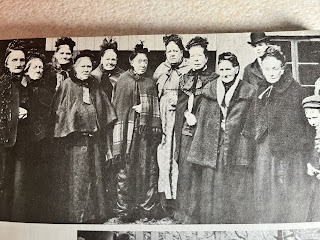So let me take you back to Good Friday in 1902 where a crowd are gathered around a table-top tomb in the tiny churchyard of St Bartholomew the Great.
This is London's oldest parish church, which stands on the fringe of the City of London. This is one of my favourite churches
The majority of those present consist of a group of twenty-one, old widows. The churchwarden then walks towards the grave. He bends down and places a silver sixpence upon the tombstone's surface.
Then one of the poor widows climbs onto the grave, kneels down, and begins to pick up the silver sixpence.
Another gentleman then hands her a hot cross bun, while a further member of the company extends a hand towards her to steady her balance which she holds on to as she continues to walk across the grave.
Once she has stepped down, the ritual is then repeated until each widow has collected her sixpence and hot cross bun. What a spectacle this must of have been to witness.
The ceremony on Good Friday in 1902 is described by Desmond Young in George Sims's exhaustive study Living London.
This custom was an ancient one known to most as ‘Widows sixpence’, the widows belonged to the parish of St. Bartholomew’s.
According to Living London the ceremony "which for centuries has been carried out practically as it is at the present time, began through the terms of a bequest by a widow whose remains lie under the stone.”
But wait a moment you don’t have to imagine this ritual as the ceremony is still performed today and you can, if you wanted to attend and witness the whole thing first hand.
During the year 1887, Joshua Butterworth a legal publisher established a trust to ensure the ceremony's future by giving the trust a sum of £21 and 10 shillings.
Once established he instructed everyone from now on to call the event ‘The Butterworth Charity’.
As the years rolled on the value of the six penny piece declined in value. The amount then distributed was changed to 2 shillings and sixpence (half a crown). Later in the 20th century the amount increased to 4 shillings. d to 2 shillings and Sixpence (half a crown) and then, later in the century, it increased again to 4 shillings.
In present times the poor widows have declined in the parish, and so the rector is the one who now clambers up onto the stone and calls out to the crowd if there are any poor widows present who are in need of 20 shillings. After this a sermon is given followed by hymns.
The church wardens then walk around the churchyard distributing hot cross buns for the congregation and clergy to enjoy.







